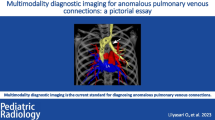Abstract
Congenital heart defect (CHD) is one of the most common birth defects and the leading course of infant mortality. Total anomalous pulmonary venous connection (TAPVC) is a rare type of cyanotic which accounting for approximately 1–3% of congenital heart disease cases. Based on where the anomalous veins drain, TAPVC can be divided into four subtypes: supracardiac, cardiac, infracardiac, and mixed. In TAPVC, all pulmonary veins fail to link to the left atrium correctly but make abnormal connections to the right atrium or systemic venous system. The mortality of TAPVC patients without proper intervention is nearly 80% in the first year of life and 50% of them died within 3 months after birth. However, the pathogenesis and mechanism of TAPVC remains elusive. In this chapter, we systematically review the epidemiology, anatomy, and pathophysiology of TAPVC and give an overview of the research progress of TAPVC pathogenesis.
Access this chapter
Tax calculation will be finalised at checkout
Purchases are for personal use only
Similar content being viewed by others
References
Pediatric Cardiac Genomics C, Gelb B, Brueckner M et al (2013) The congenital heart disease genetic network study: rationale, design, and early results. Circ Res 112(4):698–706
Jin SC, Homsy J, Zaidi S et al (2017) Contribution of rare inherited and de novo variants in 2,871 congenital heart disease probands. Nat Genet 49(11):1593–1601
Shi G, Zhu Z, Chen J et al (2017) Total anomalous pulmonary venous connection: the current management strategies in a pediatric cohort of 768 patients. Circulation 135(1):48–58
Mai CT, Riehle-Colarusso T, O’Halloran A et al (2012) Selected birth defects data from population-based birth defects surveillance programs in the United States, 2005-2009: featuring critical congenital heart defects targeted for pulse oximetry screening. Birth Defects Res A Clin Mol Teratol 94(12):970–983
Seale AN, Uemura H, Webber SA et al (2010) Total anomalous pulmonary venous connection: morphology and outcome from an international population-based study. Circulation 122(25):2718–2726
Nurkalem Z, Gorgulu S, Eren M, Bilal MS (2006) Total anomalous pulmonary venous return in the fourth decade. Int J Cardiol 113(1):124–126
Correa-Villasenor A, Ferencz C, Boughman JA, Neill CA (1991) Total anomalous pulmonary venous return: familial and environmental factors. The Baltimore-Washington Infant Study Group. Teratology 44(4):415–428
Siddharth CB, Yadav M, Bhoje A, Hote MP (2018) Dual drainage total anomalous pulmonary venous connection: a rare mixed variant. Asian Cardiovasc Thorac Ann 26(4):305–307
van den Berg G, Moorman AF (2011) Development of the pulmonary vein and the systemic venous sinus: an interactive 3D overview. PLoS One 6(7):e22055
DeRuiter MC, Gittenberger-De Groot AC, Wenink AC, Poelmann RE, Mentink MM (1995) In normal development pulmonary veins are connected to the sinus venosus segment in the left atrium. Anat Rec 243(1):84–92
Douglas YL, Jongbloed MR, Deruiter MC, Gittenberger-de Groot AC (2011) Normal and abnormal development of pulmonary veins: state of the art and correlation with clinical entities. Int J Cardiol 147(1):13–24
Douglas YL, Jongbloed MR, den Hartog WC et al (2009) Pulmonary vein and atrial wall pathology in human total anomalous pulmonary venous connection. Int J Cardiol 134(3):302–312
Bleyl SB, Botto LD, Carey JC et al (2006) Analysis of a Scottish founder effect narrows the TAPVR-1 gene interval to chromosome 4q12. Am J Med Genet A 140(21):2368–2373
Bleyl S, Nelson L, Odelberg SJ et al (1995) A gene for familial total anomalous pulmonary venous return maps to chromosome 4p13-q12. Am J Hum Genet 56(2):408–415
Bleyl SB, Saijoh Y, Bax NA et al (2010) Dysregulation of the PDGFRA gene causes inflow tract anomalies including TAPVR: integrating evidence from human genetics and model organisms. Hum Mol Genet 19(7):1286–1301
Cinquetti R, Badi I, Campione M et al (2008) Transcriptional deregulation and a missense mutation define ANKRD1 as a candidate gene for total anomalous pulmonary venous return. Hum Mutat 29(4):468–474
Nash D, Arrington CB, Kennedy BJ et al (2015) Shared segment analysis and next-generation sequencing implicates the retinoic acid signaling pathway in total anomalous pulmonary venous return (TAPVR). PLoS One 10(6):e0131514
Arimura T, Bos JM, Sato A et al (2009) Cardiac ankyrin repeat protein gene (ANKRD1) mutations in hypertrophic cardiomyopathy. J Am Coll Cardiol 54(4):334–342
Degenhardt K, Singh MK, Aghajanian H et al (2013) Semaphorin 3d signaling defects are associated with anomalous pulmonary venous connections. Nat Med 19(6):760–765
Li J, Yang S, Pu Z et al (2017) Whole-exome sequencing identifies SGCD and ACVRL1 mutations associated with total anomalous pulmonary venous return (TAPVR) in Chinese population. Oncotarget 8(17):27812–27819
Shi X, Huang T, Wang J et al (2018) Next-generation sequencing identifies novel genes with rare variants in total anomalous pulmonary venous connection. EBioMedicine 38:217–227
Shi X, Cheng L, Jiao X et al (2018) Rare copy number variants identify novel genes in sporadic total anomalous pulmonary vein connection. Front Genet 9:559
Author information
Authors and Affiliations
Editor information
Editors and Affiliations
Rights and permissions
Copyright information
© 2020 Springer Science+Business Media, LLC, part of Springer Nature
About this protocol
Cite this protocol
Shi, X., Lu, Y., Sun, K. (2020). Research Progress in Pathogenesis of Total Anomalous Pulmonary Venous Connection. In: Huang, T. (eds) Precision Medicine. Methods in Molecular Biology, vol 2204. Humana, New York, NY. https://doi.org/10.1007/978-1-0716-0904-0_15
Download citation
DOI: https://doi.org/10.1007/978-1-0716-0904-0_15
Published:
Publisher Name: Humana, New York, NY
Print ISBN: 978-1-0716-0903-3
Online ISBN: 978-1-0716-0904-0
eBook Packages: Springer Protocols




